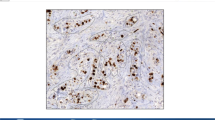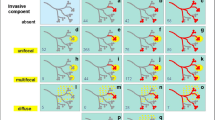Abstract
Invasive ductal carcinoma is by far the largest histological subtype of breast cancer, but clinical behavior can differ greatly. Reliable morphological markers are, therefore, of invaluable help to distinguish between patients with good and poor prognosis. Histological patterns stained with periodic acid-Schiff (PAS) were previously shown to be of prognostic significance in cutaneous and uveal melanoma. In this study, we examined the presence of different PAS-positive (PAS+) structures in 54 women with infiltrating ductal adenocarcinoma of the breast and at least one axillary lymph node metastasis but no distant metastases who were followed for at least 11 years. We found that the complexity of the thin PAS+ patterns in lymph node metastases is associated with a shorter period of disease free survival (DFS) as well as of total survival (Kaplan–Meier curves). Furthermore, the presence of PAS+ networks – the most complex thin PAS+ pattern – in lymph node metastases is one of the two independent factors associated with the occurrence of a distant metastasis (multivariate Cox model). Moreover, the presence of PAS+ networks in positive lymph nodes is the feature most strongly associated with DFS. In conclusion, the presence of PAS+ networks in lymph node metastases is a new, reliable and convenient indicator for prognosis of breast cancer patients.
Similar content being viewed by others
References
Orr RK: The impact of prophylactic axillary node dissection on breast cancer survival-a Bayesian meta-analysis. Ann Surg Oncol 6: 109–116, 1999
Folkman J: Angiogenesis in cancer, vascular, rheumatoid and other disease. Nat Med 1: 27–31, 1995
Risau W: Mechanisms of angiogenesis. Nature 386: 671–674, 1997
Hanahan D, Folkman J: Patterns and emerging mechanisms of the angiogenic switch during tumorigenesis. Cell 86: 353–364, 1996
Rak J, Kerbel RS: Treating cancer by inhibiting angiogenesis: new hopes and potential pitfalls. Cancer Metastasis Rev 15: 231–236, 1996
Kumar R, Fidler IJ: Angiogenic molecules and cancer metastasis. In vivo 12: 27–34, 1998
de Jong JS, van Diest PJ, Baak JP: Hot spot microvessel density and the mitotic activity index are strong additional prognostic indicators in invasive breast cancer. Histopathology 36: 306–312, 2000
Engels K, Fox SB, Harris AL: Angiogenesis as a biologic and prognostic indicator in human breast carcinoma. EXS 79: 113–156, 1997
Gasparini G, Harris AL: Clinical importance of the determination of tumor angiogenesis in breast carcinoma: much more than a new prognostic tool. J Clin Oncol 13: 765–782, 1995
Harris AL, Zhang H, Moghaddam A, Fox S, Scott P, Pattison A, Gatter K, Stratford I, Bicknell R: Breast cancer angiogenesis-new approaches to therapy via antiangiogenesis, hypoxic activated drugs, and vascular targeting. Breast Cancer Res Treat 38: 97–108, 1996
Clarijs R, Otte-Holler I, Ruiter DJ, de Waal RM: Presence of a fluid-conducting meshwork in xenografted cutaneous and primary human uveal melanoma. Invest Ophthalmol Vis Sci 43: 912–918, 2002
Folberg R, Pe'er J, Gruman LM, Woolson RF, Jeng G, Montague PR, Moninger TO, Yi H, Moore KC: The morphologic characteristics of tumor blood vessels as a marker of tumor progression in primary human uveal melanoma: a matched case-control study. Hum Pathol 23: 1298–1305, 1992
Thies A, Mangold U, Moll I, Schumacher U: PAS-positive loops and networks as a prognostic indicator in cutaneous malignant melanoma. J Pathol 195: 537–542, 2001
Folberg R, Rummelt V, Parys-Van Ginderdeuren R, Hwang T, Woolson RF, Pe'er J, Gruman LM: The prognostic value of tumor blood vessel morphology in primary uveal melanoma. Ophthalmology 100: 1389–1398, 1993
Warso MA, Maniotis AJ, Chen X, Majumdar D, Patel MK, Shilkaitis A, Gupta TK, Folberg R: Prognostic significance of periodic acid-Schiff-positive patterns in primary cutaneous melanoma. Clin Cancer Res 7: 473–477, 2001
Foss AJ, Alexander RA, Hungerford JL, Harris AL, Cree IA, Lightman S: Reassessment of the PAS patterns in uveal melanoma. Br J Ophthalmol 81: 240–246, 1997
McLean IW, Keefe KS, Burnier MN: Uveal melanoma. Comparison of the prognostic value of fibrovascular loops, mean of the ten largest nucleoli, cell type, and tumor size. Ophthalmology 104: 777–780, 1997
Maniotis AJ, Folberg R, Hess A, Seftor EA, Gardner LM, Pe'er J, Trent JM, Meltzer PS, Hendrix MJ: Vascular channel formation by human melanoma cells in vivo and in vitro: vasculogenic mimicry. Am J Pathol 155: 739–752, 1999
van den Broek LJ, van de Vijver MJ: Assessment of problems in diagnostic and research immunohistochemistry associated with epitope instability in stored paraffin sections. Appl Immunohistochem Mol Morphol 8: 316–321, 2000
Hazelbag HM, van den Broek LJ, van Dorst EB, Offerhaus GJ, Fleuren GJ, Hogendoorn PC: Immunostaining of chainspecific keratins on formalin-fixed, paraffin-embedded tissues: a comparison of various antigen retrieval systems using microwave heating and proteolytic pre-treatments. J Histochem Cytochem 43: 429–437, 1995
Valtola R, Salven P, Heikkila P, Taipale J, Joensuu H, Rehn M, Pihlajaniemi T, Weich H, deWaal R, Alitalo K: VEGFR-3 and its ligand VEGF-C are associated with angiogenesis in breast cancer. Am J Pathol 154: 1381–1390, 1999
Lee HD, Yoon DS, Koo JY, Suh CO, Jung WH, Oh KK: Breast conserving therapy in stage I & II breast cancer in Korea. Breast Cancer Res Treat 44: 193–199, 1997
Noguchi M, Yagasaki R, Kawahara F, Minami M, Tsuyama H, Earashi M, Kinoshita K, Taniya T, Miwa K, Nishijima H, Takanaka T, Kawashima H, Takashima C, Kanno M, Nakamura S, Mizukami Y, Nonomura A, Michigishi T, Yokoyama K: Breast conserving treatment versus modified radical mastectomy in Japanese patients with operable breast cancer. Int Surg 82: 289–294, 1997
van Tienhoven G, Voogd AC, Peterse JL, Nielsen M, Andersen KW, Mignolet F, Sylvester R, Fentiman IS, van der SE, van Zijl K, Blichert-Toft M, Bartelink H, van Dongen JA: Prognosis after treatment for loco-regional recurrence after mastectomy or breast conserving therapy in two randomised trials (EORTC 10801 and DBCG-82TM). EORTC Breast Cancer Cooperative Group and the Danish Breast Cancer Cooperative Group. Eur J Cancer 35: 32–38, 1999
Petersen OW, Lind NH, Gudjonsson T, Villadsen R, Ronnov-Jessen L, Bissell MJ: The plasticity of human breast carcinoma cells is more than epithelial to mesenchymal conversion. Breast Cancer Res 3: 213–217, 2001
Thiery JP: Epithelial-mesenchymal transitions in tumour progression. Nat Rev Cancer 2: 442–454, 2002
Dandachi N, Hauser-Kronberger C, More E, Wiesener B, Hacker GW, Dietze O, Wirl G: Co-expression of tenascin-C and vimentin in human breast cancer cells indicates phenotypic transdifferentiation during tumour progression: correlation with histopathological parameters, hormone receptors, and oncoproteins. J Pathol 193: 181–189, 2001
Sharma N, Seftor RE, Seftor EA, Gruman LM, Heidger Jr PM, Cohen MB, Lubaroff DM, Hendrix MJ: Prostatic tumor cell plasticity involves cooperative interactions of distinct phenotypic subpopulations: role in vasculogenic mimicry. Prostate 50: 189–201, 2002
Hendrix MJ, Seftor EA, Kirschmann DA, Seftor RE: Molecular biology of breast cancer metastasis. Molecular expression of vascular markers by aggressive breast cancer cells. Breast Cancer Res 2: 417–422, 2000
McDonald DM, Munn L, Jain RK: Vasculogenic mimicry: how convincing, how novel, and how significant? Am J Pathol 156: 383–388, 2000
Folberg R, Hendrix MJ, Maniotis AJ: Vasculogenic mimicry and tumor angiogenesis. Am J Pathol 156: 361–381, 2000
Fausto N: Vasculogenic mimicry in tumors. Fact or artifact? Am J Pathol 156: 359, 2000
Bissell MJ: Tumor plasticity allows vasculogenic mimicry, a novel form of angiogenic switch. A rose by any other name? Am J Pathol 155: 675–679, 1999
Sood AK, Seftor EA, Fletcher MS, Gardner LM, Heidger PM, Buller RE, Seftor RE, Hendrix MJ: Molecular determinants of ovarian cancer plasticity. Am J Pathol 158: 1279–1288, 2001
Shirakawa K, Wakasugi H, Heike Y, Watanabe I, Yamada S, Saito K, Konishi F: Vasculogenic mimicry and pseudocomedo formation in breast cancer. Int J Cancer 99: 821–828, 2002
Shirakawa K, Tsuda H, Heike Y, Kato K, Asada R, Inomata M, Sasaki H, Kasumi F, Yoshimoto M, Iwanaga T, Konishi F, Terada M, Wakasugi H: Absence of endothelial cells, central necrosis, and fibrosis are associated with aggressive inflammatory breast cancer. Cancer Res 61: 445–451, 2001
Ruoslahti E: Specialization of tumour vasculature. Nat Cancer Rev 2: 83–90, 2002
Author information
Authors and Affiliations
Rights and permissions
About this article
Cite this article
Buijs, J.T., Cleton, AM., Smit, V.T. et al. Prognostic Significance of Periodic Acid-Schiff-Positive Patterns in Primary Breast Cancer and its Lymph Node Metastases. Breast Cancer Res Treat 84, 117–130 (2004). https://doi.org/10.1023/B:BREA.0000018408.77854.d1
Issue Date:
DOI: https://doi.org/10.1023/B:BREA.0000018408.77854.d1




